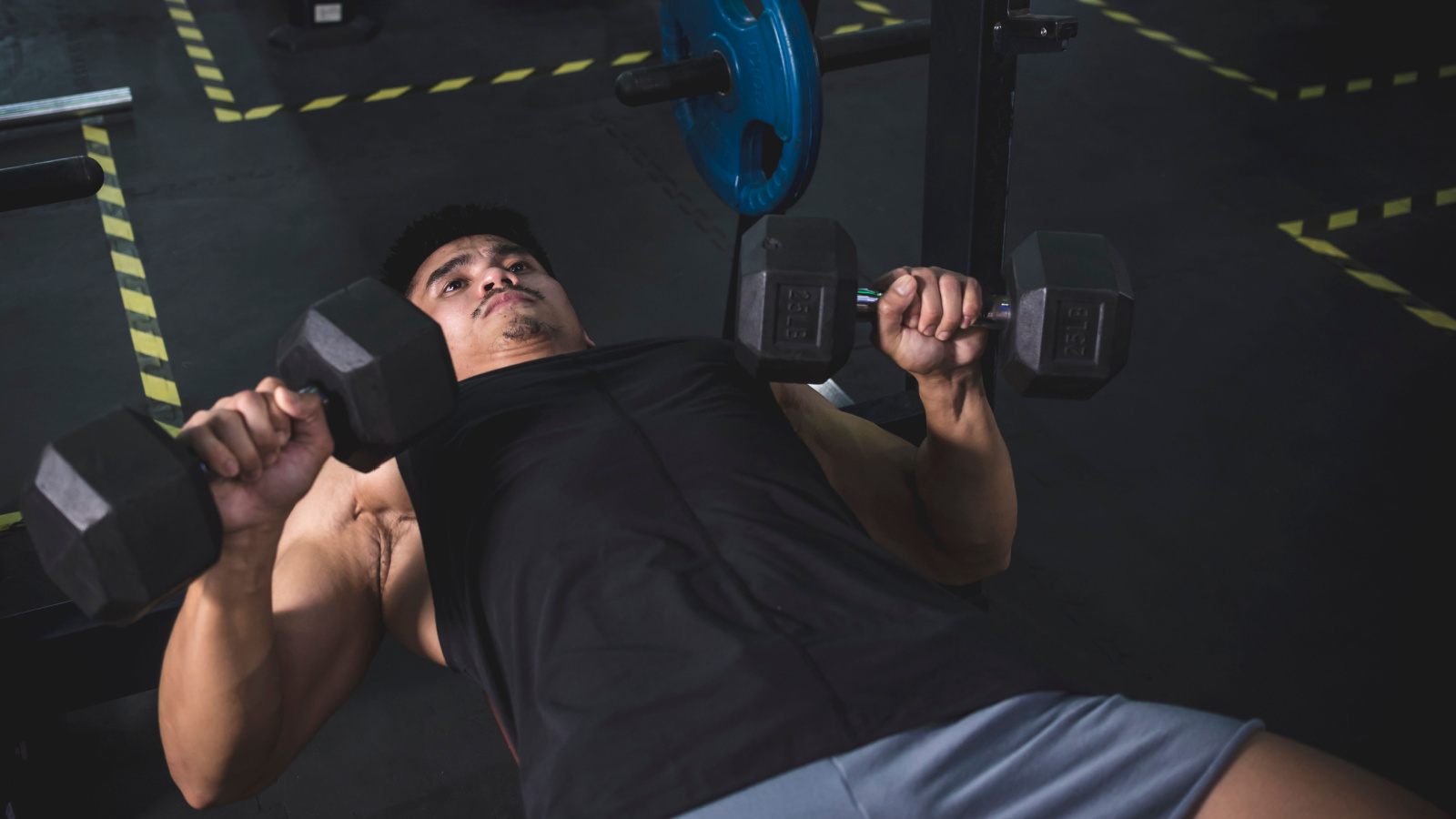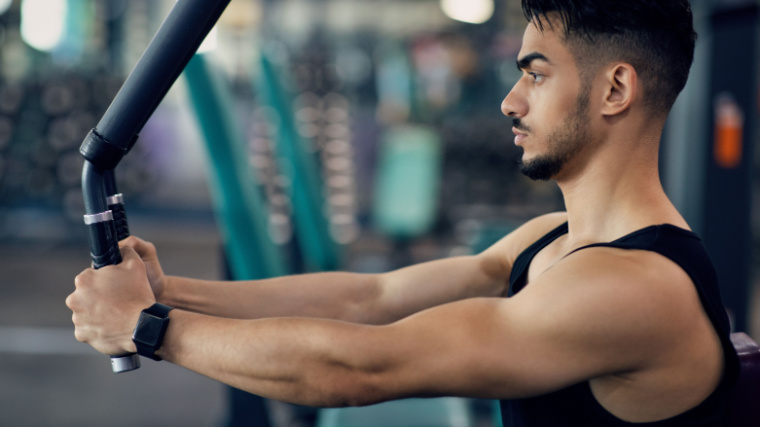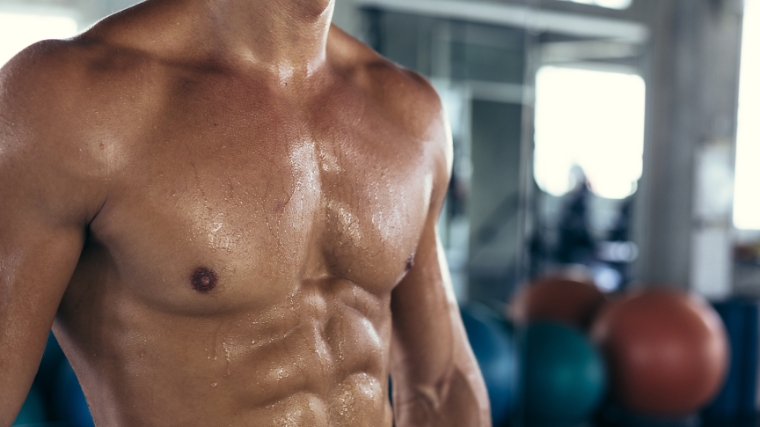
Among experienced lifters, heading into the gym for a focused chest and triceps workout stands as a testament to serious commitment. From powerlifters aiming for their next bench press PR to bodybuilders striving for a near-perfect physique, these sessions are fundamental in the lifting world. It’s not just about the aesthetics; it’s about strength, resilience, and dedication.
Training your chest and triceps together offers a balanced approach, maximizing both push mechanics and muscle engagement. Whether you’re a seasoned athlete or someone just starting out, there’s always room to refine technique, push boundaries, and see genuine progress.

This workout uses an approach inspired by the “Mountain Dog” — legendary bodybuilding coach John Meadows. This method consists in a specific sequencing of exercises thought out to maximize the mind-muscle connection, build the muscular pump, and preserve longevity in the gym. Time to dive in and elevate your chest and triceps game to the next level.
Chest and Triceps Workout
How to Warm-up for a Better Chest and Triceps Workout
Warming up before diving into an intense chest and triceps workout isn’t just a suggestion — it’s an essential step. A proper warm-up primes the body, gradually increasing the heart rate, enhancing blood flow to the muscles, and lubricating the joints. This ensures not only optimal muscle engagement and flexibility but also significantly reduces the risk of injuries. (1)
This is especially true for sessions involving the shoulder joint (chest, shoulders, or “pushing” workouts) as it is the most flexible, but also relatively fragile, in the body. Without this preparatory phase, muscles remain stiff, making them more susceptible to strains or pulls, and joints can be caught off guard, leading to unnecessary stress or even long-term damage.
Warming up has mental benefits, as well. It provides a transition period, allowing you to mentally prepare and focus on the upcoming workout. This mental shift from rest to activity is crucial for optimal performance, ensuring that both the body and mind are in sync. Thus, skipping the warm-up not only jeopardizes physical health but also diminishes the overall quality and effectiveness of the workout. (2)
- Band Over-and-Back: Hold a light resistance band at shoulder-height with an overhand grip and your elbows straight. Slightly hinge forward so that you don’t “cheat” the exercise by arching your back. Remain in that position, squeeze your shoulder blades together, and extend your arms out to the sides to provide tension. Keep your arms straight the whole time and move the band from in front of you, up and overhead, and behind your back as far as comfort and mobility allow. Then bring the band back to the initial position. Perform 10 repetitions before moving on the next exercise.
- Band Pull-Apart: Stand fully upright and begin with your hands together in front of you at chest-height. Stretch the band by pulling the band apart and squeezing your shoulder blades together until your arms are extended to form a T-shape out to the sides. Repeat for 12 to 15 repetitions and move on to the last exercise.
- Band Triceps Extension: Loop the band around a stable overhead support like a power rack so that it is above head-height. Grab the band with both hands, brace your core, and bend slightly forward. While keeping your elbows glued to your ribs, extend your forearms down, then flex your upper arms to stretch your triceps before extending them again. Repeat for 30 to 50 reps. Repeat this entire circuit one or two more times for a thorough warm-up.
The Tried and True Chest and Triceps Workout
This workout consists of six exercises — four chest exercises and two triceps exercises — organized in a specific manner to reap the most benefits. You can perform it once or twice per week, depending on whether you find these body parts to be a “weak point” or not.
The chest and triceps workout can be include in either a traditional body part-focused workout split or as a “pushing workout” in a push/pull/leg plan, with a second push day focusing on the shoulders instead of the chest.
Chest and Triceps Workout Summary
- Slight Decline Dumbbell Bench Press — 4 x 8
- Slight Incline Barbell Bench Press — 3 x 6-8
- Machine Chest Press — 1 x 15 with triple rest-pause
- Pec-Deck — 2 x 12-15 with iso-holds
- Rope Pushdown — 2 x 12-15
- Lying Triceps Extension — 3 x 8-12
Slight Decline Dumbbell Bench Press
First, we launch with the decline dumbbell bench press. It’s all about activation — think of the exercise as coffee for your chest. Discard the typical “barbell exercise first” approach many lifters use and, instead, take a more for a joint-friendly approach. The decline position, as well as using dumbbells, will help you feel and activate your chest muscles better. (3)(4) This way, you’ll reduce the risk of injury and you’ll be able to recruit your chest better in the next exercises.
The devil’s in the detail and, for a better chest recruitment and comfort, we want to use slight angles or we risk shifting the load away from the pecs and onto the shoulders or triceps. So don’t get crazy with the decline and use a roughly 10-degree angle — or place a single 25 or 45-pound weight plate under the foot-end of a flat bench. Always perform a few warm-up sets beforehand, as it is the first exercise of the session and your shoulder joints still need gradual preparation.
- How to do it: Lay down on the decline bench with a pair of dumbbells in your hands. Depending on your individual set-up, secure your feet under the pad, on a step, or on the plate you put under the bench for elevation. Slightly arch your upper back, squeeze your shoulder blades, and press the weight up while exhaling, making sure you keep your elbows and wrists aligned without flaring them or tilting them backward. Lower the weight with your palms facing forward, using control until the sides of the dumbbells are almost touching your chest. Press back to the starting position.
- Sets and Reps: 4 x 8
- Rest Time: Rest 90 to 120 seconds between sets.
Benefits of the Slight Decline Dumbbell Bench Press
- The dumbbells allow for a more natural and joint-friendly motion, making it an ideal exercise to start a session.
- The slight decline increases the recruitment of the chest compared to the triceps and shoulders, improving your mind-muscle connection and muscle growth.
- The slight decline focuses on the sternal portion of the pectoralis (lower chest) which can be a benefit if your physique is lagging in this area.
Slight Incline Barbell Bench Press
Next up is the incline barbell bench press for those craving power and oomph. After the “activation” exercise, it’s time for the “explosive” phase with a big barbell movement. This will let you use a ton of weight to promote hypertrophy through mechanical tension. It’s still early in the session, so you should have a good deal of strength left.
This is called the “explosive” exercise because we want to move the barbell as fast as possible during the concentric phase (when you push the weight up) in order to improve strength and recruit as many type II fibers as possible — these are the biggest muscle fibers, the ones we’re after to optimize growth.
The slight incline bench press is an excellent pièce de résistance, as the incline will focus on the upper chest, a body part many lifters are deficient in. Once again, aim for a slight angle instead of a steep incline. Something like 15 to 30-degrees will better recruit the chest instead of the anterior deltoids. (5) Aim for heavy sets of six the first week, then try to do 7, then 8 reps with the same weight the following weeks before increasing it.
- How to do it: Set up an adjustable bench to a 15 to 30-degree angle and lay on it. Squeeze your shoulder blades together so they lay flat on the bench. Unrack the barbell, using a grip around 1.5-times your shoulder-width. Squeeze the bar hard and lower it with control toward your clavicles or upper chest. Stop a couple inches before touching it, if your shoulders are problematic, and press the weight up as hard and fast as you can while exhaling.
- Sets and Reps: 3 x 6-8
- Rest Time: Rest two to three minutes between sets.
Benefits of the Slight Incline Barbell Bench Press
- An incline angle, even a slight one, activates the clavicular head (upper part) of the pectoralis major more than a flat bench. This makes it particularly useful for those looking to enhance the definition and size of their upper chest.
- The slight incline position may reduce the amount of stress on the anterior deltoid and the rotator cuff, as compared to a flat bench press. This potentially minimizes the risk of shoulder injuries, especially for those with pre-existing shoulder conditions.
- The slight incline angle might have more carryover to everyday activities and sports that require pushing or throwing at an upward angle. This functional strength is useful not just for athletes but also in daily life scenarios.
Machine Chest Press
Now we use a chest press machine to chase that coveted pump. Ever been so pumped you felt like you could bounce coins off your chest? If not, you soon might be. We’re aiming for that in the “pump” phase by driving a lot of nutrients, metabolites, and blood into the muscles to stimulate sarcoplasmic hypertrophy. This can increase the volume of the muscle cells and potentially trigger even more growth. For a great pump effect, you want an exercise which will be relatively safe to go to failure so you can really push yourself, while also targeting your chest as much as possible.
The machine chest press is a perfect fit as it develops the chest as a whole, rounding out the previous angle-focused pummeling. A quality machine doesn’t necessitate balance or high-level technique, so the movement is more secure. End with the high-intensity rest-pause technique to push yourself out of your comfort zone and stimulate maximum muscle growth. (6) Aim for a very hard set of 15 repetitions, then wait for 20 seconds, and do as many reps as you can with the same weight. Then do it again twice! It will mostly likely be only a few reps the last time.
- How to do it: Find your favorite chest press machine and get in securely. Set the bench height so your hands are around mid-chest level in the starting position. Load the machine, puff your chest and squeeze your shoulder blades, and extend your arms by pushing through the handles until they are straight. Reverse the motion with control, while still remaining braced.
- Sets and Reps: 1 x 15 with triple rest-pause — perform 15 reps to muscular failure, rest briefly, reduce the weight and perform more reps to failure. Rest briefly, reduce the weight and continue. Rest briefly again, and repeat one final time.
- Rest Time: Rest 20 to 30 seconds for each rest-pause.
Benefits of the Machine Chest Press
- One of the main advantages of using machines is safety. For those lifting heavy or working up to (or beyond) muscle fatigue, machines reduce the risk of dropping weights or failing mid-rep.
- The machine chest press can provide targeted stimulation without the interference of stabilizing muscles, allowing you to fully feel and focus on your chest.
- The rest-pause method effectively increases time under tension and metabolic stress, both of which are critical factors for muscle growth.
Pec-Deck Machine
Rounding off the chest, the pec-deck (or machine chest flye) offers the stretch you didn’t know you needed but won’t forget anytime soon. Now that our muscles are really warmed up, we can safely use exercises emphasizing the stretch without injury. The stretch is not only great to improve mobility, but also is linked to more muscle growth. (7)
You could use cable crossovers instead, but the pec-deck machine has the benefit of nullifying the balance and bracing needed so that you can only focus on your muscles. It’s a superb exercise to isolate your chest and deep dive into the stretch with a minimal set-up time and effort. Do hard sets of 15 repetitions and, after the final rep, pause in the stretch position for 15 seconds to keep stimulating the muscle beyond failure.
- How to do it: Sit on the machine and set the seat height so that your arms are at shoulder-level or slightly lower. Squeeze your shoulder blades together and brace your core. Bring your arms together in front of you and flex your chest as hard as possible on each repetition. Reverse the motion with control as far as possible while still being able to keep tension in your chest and repeat for the desired amount of repetitions. On the last repetition, hold the stretch position for 15 seconds.
- Sets and Reps: 2 x 12-15 using a 15-second iso-hold at the end of each set.
- Rest Time: Rest 90 seconds between sets.
Benefits of the Pec-Deck Machine
- The pec-deck isolates the pectoral muscles effectively, allowing for a concentrated workout on the chest without assistance from the shoulders or triceps.
- The pec-deck allows for a deep stretch at the beginning phase of the movement, which can gradually increase range of motion in the shoulder joint and potentially promote muscle hypertrophy.
- The fixed path of the machine ensures a consistent range of motion, ensuring that the muscles are worked through a specific and consistent arc. This can be particularly beneficial for reinforcing proper movement patterns and ensuring balanced development on both sides of the body.
Rope Pushdown
Now it’s time to hammer your triceps. Doing them last ensures you can lift the most weight during your chest exercises, and that your sensitive elbow joints are completely ready for the pummeling ahead. In the same spirit, we’re going to use the classic triceps pushdown with a rope attachment, a very joint-friendly exercise. Stick to isolation exercises to simply finish off your triceps because they were already stimulated a lot during the chest-focused part of the session.
This exercise is a perfect fit to start the triceps segment as the rope allows for a smooth and natural motion, enhancing mind-muscle connection without putting excessive stress on the elbows.
- How to do it: Stand in front of a pulley station and set it as high as possible. Attach a rope to it. If you’re a long-limbed lifter, you could even attach two ropes for an increased range of motion, grabbing one with each hand. Slightly bend your knees and hinge forward so that you don’t accidentally hit yourself below the belt while performing the exercise. Brace your core and extend your arms down while making sure that only your forearms are moving. In the bottom position, squeeze your triceps as hard as you can for a second. Slowly flex back your arms to stretch your triceps and repeat for the desired amount of reps.
- Sets and Reps: 2 x 12-15
- Rest Time: Rest 60 to 90 seconds between sets.
Benefits of the Rope Pushdown
- Using a rope attachment allows for greater range of motion than a straight bar, ensuring optimal triceps engagement compared to other triceps exercises.
- The controlled movement of the pushdown, especially when done using cables and a rope, places less stress on the elbow joint compared to free-weight triceps exercises. This can be advantageous for those with elbow issues or looking to prevent strain.
- The rope allows users to spread the ends apart at the bottom of the movement, providing an additional contraction or “squeeze” in the triceps. This can further enhance muscle activation and hypertrophy potential.
Lying Triceps Extension
We’re saving the best for last, as the lying triceps extension is a meat and potatoes movement in triceps training. You can use a ton of weight, thus promoting incredible strength and hypertrophy. But this exercise can be hard on the joints and we want to keep egos in check to avoid any injury. This exercise is also called the “skull crusher,” so doing it at the end of a session means that your joints will better tolerate the stress, and you won’t be able to use as much weight because of the cumulative fatigue.
In any case, this exercise remains the king of triceps isolation exercises, so don’t think for a minute that it won’t make your arms stretch your sleeves. If you have bad wrists, feel free to use the EZ bar, as this squiggly thing can be easier on the joints.
- How to do it: Grab a barbell with a pronated (palm down) grip, shoulder-width or slightly closer, and lay down on a flat bench. Extend your arms toward the ceiling and brace your core. From there, bend your arms and have the barbell stop an inch before it touches your forehead — move only your forearms, not your upper arms or shoulders — then press the weight up forcefully.
- Sets and Reps: 3 x 8-12
- Rest Time: Rest 60 to 90 seconds between sets.
Benefits of the Lying Triceps Extension
- One of the primary benefits of this exercise is the ability to use relatively heavy weights compared to some other triceps isolation exercises. Heavier loads can produce greater mechanical tension on the muscle fibers, a critical factor for muscle growth.
- The lying triceps extension is particularly effective at targeting the long head of the triceps, which is the largest of the three triceps heads.
- This exercise has a pronounced eccentric (muscle-lengthening or lowering) phase. Eccentric actions have been associated with greater muscle damage, which can be a stimulus for muscle repair and growth.
Muscles Trained During the Workout
When you’re performing a chest and triceps workout, you’ll use various exercises to target these muscles, ensuring comprehensive development. Compound movements like bench presses engage multiple muscle groups, while isolation exercises like triceps pushdowns or chest flies focus more specifically on one group.
Pectoralis Major
This is the largest muscle in the chest, well, the one we simply call “the chest.” The clavicular head (upper chest) originates from the clavicle and helps in flexing the humerus (as in lifting the arm in front of you). The sternal head (lower/mid-chest) originates from the sternum and aids in adducting and rotating the humerus (as in flapping the arm down and inward).

Exercises done on an horizontal plane work the pectoralis as whole, while incline variations target the upper chest, and decline exercises work more the lower chest.
Triceps Brachii
Located on the back of the upper arm, it has three heads. The long head is the largest and runs along the back of the arm. It plays a role in extending the arm and adducting it (moving it toward the body). The lateral head is located on the outer side of the arm, giving the triceps its horseshoe shape. Finally, the medial head is deeper and runs beneath the long and lateral heads. It assists in extending the forearm.
Deltoids
While the pectorals and triceps are the primary focus, the anterior deltoid (front shoulder) is unavoidably activated and worked to a significant degree. This overlap is one reason why many training programs often pair chest with shoulders or allow adequate rest between chest and shoulder workouts to ensure the anterior deltoids recover properly. The middle and posterior deltoids are also recruited to an extent especially on incline movements or as stabilizer.
Unlocking Upper Body Excellence
There’s an art and science to effective training and this workout beautifully melds both. By prioritizing joint health and muscle activation, we’re not just lifting weights; we’re sculpting an upper body masterpiece. The thoughtful arrangement of exercises, combined with techniques like iso-holds and rest-pauses, ensures each muscle fiber is recruited for maximum gain.
So as you power through each rep, remember that it’s more than just motion — it’s purposeful progress. Whether you’re a seasoned gym-goer or stepping onto the workout floor for the first time, this chest and triceps routine promises results that speak for themselves. Give it your all and watch as strength, definition, and confidence become your workout rewards.
References
- Fradkin AJ, Gabbe BJ, Cameron PA. Does warming up prevent injury in sport? The evidence from randomised controlled trials? J Sci Med Sport. 2006 Jun;9(3):214-20. doi: 10.1016/j.jsams.2006.03.026. Epub 2006 May 6. PMID: 16679062.
- McCrary JM, Ackermann BJ, Halaki M. A systematic review of the effects of upper body warm-up on performance and injury. British Journal of Sports Medicine 2015;49:935-942.
- Farias DA, Willardson JM, Paz GA, Bezerra ES, Miranda H. Maximal Strength Performance and Muscle Activation for the Bench Press and Triceps Extension Exercises Adopting Dumbbell, Barbell, and Machine Modalities Over Multiple Sets. J Strength Cond Res. 2017 Jul;31(7):1879-1887. doi: 10.1519/JSC.0000000000001651. PMID: 27669189.
- Saeterbakken AH, Mo DA, Scott S, Andersen V. The Effects of Bench Press Variations in Competitive Athletes on Muscle Activity and Performance. J Hum Kinet. 2017 Jun 22;57:61-71. doi: 10.1515/hukin-2017-0047. PMID: 28713459; PMCID: PMC5504579.
- Rodríguez-Ridao, D.; Antequera-Vique, J.A.; Martín-Fuentes, I.; Muyor, J.M. Effect of Five Bench Inclinations on the Electromyographic Activity of the Pectoralis Major, Anterior Deltoid, and Triceps Brachii during the Bench Press Exercise. Int. J. Environ. Res. Public Health 2020, 17, 7339. https://doi.org/10.3390/ijerph17197339
- Krzysztofik M, Wilk M, Wojdała G, Gołaś A. Maximizing Muscle Hypertrophy: A Systematic Review of Advanced Resistance Training Techniques and Methods. Int J Environ Res Public Health. 2019 Dec 4;16(24):4897. doi: 10.3390/ijerph16244897. PMID: 31817252; PMCID: PMC6950543.
- Warneke K, Brinkmann A, Hillebrecht M, Schiemann S. Influence of Long-Lasting Static Stretching on Maximal Strength, Muscle Thickness and Flexibility. Front Physiol. 2022 May 25;13:878955. doi: 10.3389/fphys.2022.878955. PMID: 35694390; PMCID: PMC9174468.
Featured Image: MDV Edwards / Shutterstock






